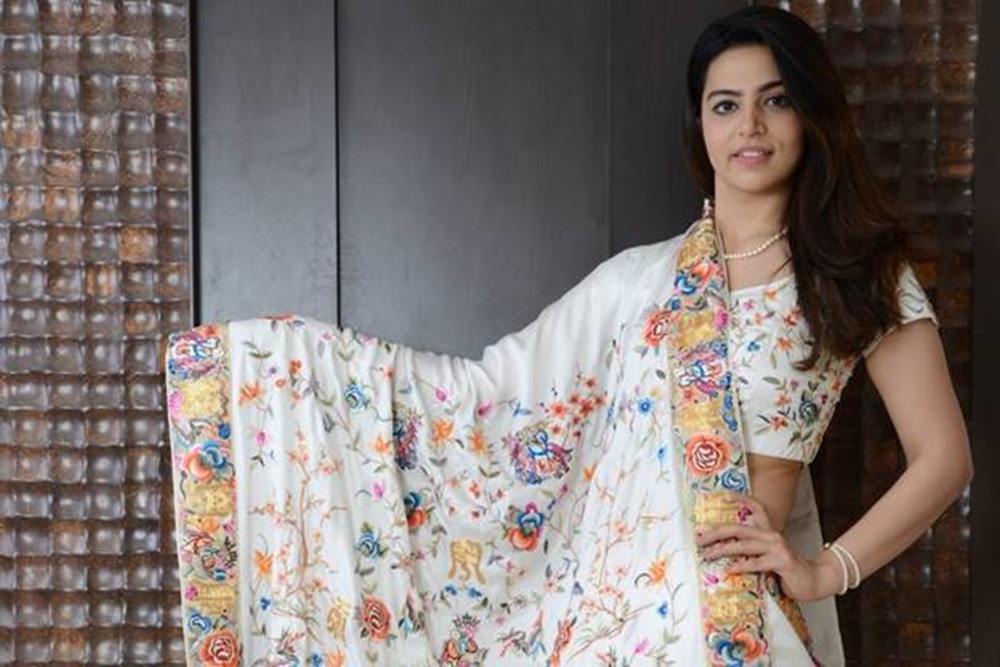Nineteenth century Parsee traders returned to India from Canton with embroidered silk cloth which was fashioned into unique saris which came to be known as garas
Traditional Parsee embroidery has its roots in ancient Persian culture and Silk Road influences, with proponents of the craft hoping to popularise it globally
Article by Huzan Tata | South China Morning Post
A gara with multicoloured embroidery of Chinese motifs and initials in gold on the border (kor) and front (pallav). Photo: Courtesy of Zenobia Davar
One of the first questions many people ask when meeting a Parsee woman is “How many garas do you own?” The intricately-designed sari is considered the small Indian
community’s traditional dress and has long been admired for its unique handiwork.
There are fewer than 90,000 Parsees remaining across the world, with most living in India after they migrated there in the 7th century following the Islamic conquest of Persia (
Iran). They are known for their contributions in fields from the economy to the arts, and their fabrics are just as significant.
The gara, draped like a Gujarati sari, is considered their pièce de résistance in the world of textiles. But they are more than just yards of cloth – garas are an amalgamation of many cultural worlds woven into one fabric.
A dark green sari with a white floral border from Ashdeen’s Emperor’s Garden Collection. Photo courtesy of Ashdeen Lilaowala
How did this mix come to be? During the early 1800s, Parsee traders frequented the ports of Canton (Guangdong), Hong Kong, Macau and Shanghai to sell Indian cotton, opium and spices in return for Chinese tea, porcelain and silk. Rumour has it that one of these traders asked a Chinese craftsman to embroider six yards of silk cloth for his wife, to fashion as a sari. This was well received and more Parsees started wearing these pieces, which came to be known as garas – the wooden frame within which the weaving is done.
Parsee embroidery style has its roots in Persia, though, and only later absorbed influences from Chinese needlework and designs, as well as Indian and European motifs. “Since Zoroastrianism [the religion Parsees follow] spread right to the borders of China during the Achaemenid Empire till 330BC, there was a lot of intermingling of culture, style, symbol and stitch,” explained Dr Shernaz Cama, director of the Unesco Project for the Preservation and Promotion of Parsee Zoroastrian Culture and Heritage (ParZor).
“With the emergence of the Silk Route, Persians and the Chinese began looking to one another for their wealth of embroidery,” she said. The Chinese chain stitch, along with the satin, long and short stitches, remain popular methods of needlework on garas, originally made from mulberry silk.
When 19th century Parsee traders began returning from China with embroidered silk, the first garas had Chinese motifs like the Divine Fungus, the Endless Knot, roosters, pagodas, foliage and butterflies. Soon, as more women took interest in these garments, they adapted them to their tastes and traditions. Instead of the multicoloured Chinese fabrics, they would ask for embroidery in white and cream on dark colours to match with their sudrehs – a muslin undergarment worn by all Zoroastrians, visible from underneath the sari.
Persian symbols of nature, and Indian motifs like the ‘ambi’ or mango paisley were also added. Plain saris with elaborate borders known as ‘kors’ were designed, or those with embroidery only on the ‘pallav’, the front of the sari. Children’s tunics or ‘jhablas’ and borders for capri-length pantaloons called ‘ijars’ were popular items too.
A 19th century ‘Cheena Cheeni’ gara brought from China for an engagement in a Parsi family. Photo courtesy of Parzor
Ashdeen Lilaowala, a renowned Indian fashion designer who specialises in Parsee embroidery and has worked with the ParZor Project, said he travelled through Iran and China to trace the roots of gara-making and “find a connection between the motifs”.
“During my travels, I discovered that this was a proper trade, with families of Canton whose livelihood ran on this exchange. The women chose designs; the men were involved in the selling. Garas were ultimately an amalgam of Chinese art with Persian influences on a very Indian garment, with sprinkles of a European aesthetic.”
As British influence grew in several spheres of Indian life during colonial times, it made its way onto the gara too – scalloped borders and motifs of baskets, bows and ribbons were incorporated on pieces. While saris that feature figures and scenes of Chinese men and women are known as ‘Cheena-Cheeni’ (the Gujarati term for people from China) garas, the ‘kanda-papeta’ (onions and potatoes) garas have round baubles, giving them their name. The ‘Chakla-Chakli’ gara is dominated by sparrows (chakli) and floral designs.
Every single gara, every single design has a story behind it. It’s ultimately a heritage of humanity, because it merges the best of the East and West Dr Shernaz Cama
“Cranes are one of our popular motifs apart from the ‘Cheena-Cheeni’. A lot of people love florals, so we do detailed chrysanthemums, peonies and roses as well,” said Lilaowala about his brand, Ashdeen.
Mumbai-based designer Zenobia Davar, who has been creating garas for almost two decades, said garas on off-white silks with pastel shades have their own charm apart from those in traditional purple, red and black. “The beauty depends upon the uniqueness of the design, and blend of colours and stitches used … it’s nothing less than painting with a needle.”
One gara can take from three weeks to several months to stitch, depending on the intricacy of the work, with the more detailed ones costing upwards of 80,000 rupees (US$1,o62) due to the skill involved. Many prefer to buy machine-made saris as they are more affordable, but they lose out on the charm and authenticity of a handstitched gara.
While traditional garments are considered family heirlooms today, production declined when many Parsees tore up or gave away their garas in the 1930s and 40s, complaining they were too heavy to wear and maintain.
Handstitched clutch purses with Persian, Chinese and floral motifs. Photo courtesy of Zenobia Davar
“Fashion changed; due to the growing nationalist movement in India, people wanted to wear more khadi, the locally handwoven natural fibre cloth popularised by Mahatma Gandhi, and the affluent gravitated towards French chiffon. That’s when people realised we were losing out on this craft,” explained Cama.
“Since I inherited authentic garas for my wedding, I realised their precious value. If we don’t preserve our inheritance of this rare art in its original form, it will perish forever. So I provide regular work as well as train artisans in this field, creating an awareness about authentic Parsee embroidery,” Davar said.
The handful of designers who create garas have diversified into creating bags, clutches, shawls, tops, and lehengas – the long skirt and crop-top that many Indian women wear for celebrations – using this style. As fancy saris are rarely worn in daily life, these products help to keep up sales and provide artisans with work. “We continue to pay homage to what constitutes a gara – the motifs, stitching and designs – with newer collections and ideas,” said Lilaowala.
As the craft is relatively unknown outside India, its proponents wish to take it to global audiences someday. Said Cama: “I hope more people popularise this art – every single gara, every single design has a story behind it. It’s ultimately a heritage of humanity, because it merges the best of the East and West.”
Huzan Tata is an independent journalist based in Mumbai, India. She writes on arts, culture, books, lifestyle and travel. Her work has been published in National Geographic Traveller India, TimeOut, Travel + Leisure India & South Asia, Verve Magazine, Scroll, and more.





